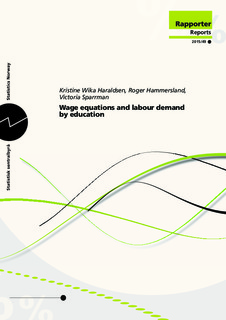| dc.description.abstract | This report presents new research on the labour market in a special version the macroeconomic model MODAG. New wage relations and demand functions are estimated using new knowledge and the latest available data.
This report presents new research on the labour market in a special version the macroeconomic model MODAG. New wage relations and demand functions are estimated using new knowledge and the latest available data. These relations are the basis for new projections of demand for labour until 2030, and the results are compared to the previous report on employment by education by Cappelen, Gjefsen, Gjelsvik, Holm and St.len (2013). The wage relations describing education-specific wage formation were previously estimated by Bj.rnstad and Skjerpen (2006), and Gjelsvik (2013) provided a documentation of the previous model of demand for labour by education and industry. The previous wage relations were constructed using data from 1972 to 1997, and the previous demand functions used data from 1972 to 2007. | nb_NO |
